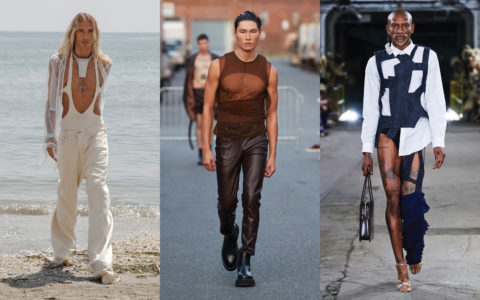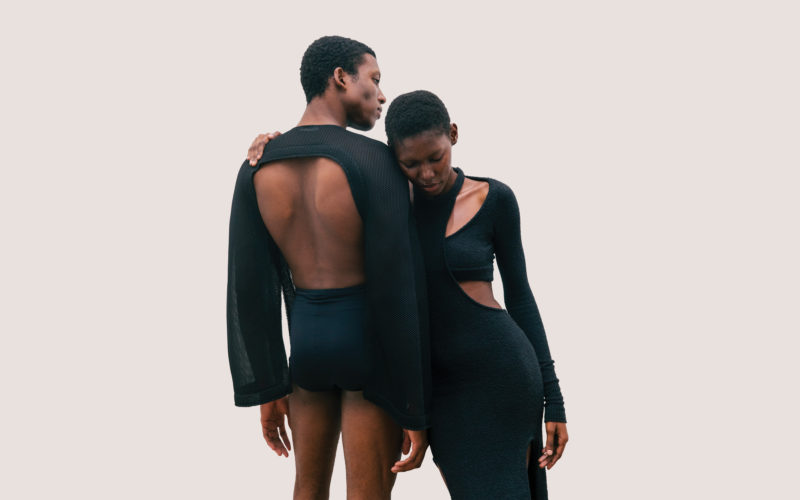“There are no more rules today about whose body or body type can go scantily clad.”
Is cut-out clothing the key to genderless expression? My mother used to complain about the cost of “incomplete clothing.” Made restless by our suburban neighbourhood, we would sometimes drive to the shopping mall one town over, and, to my preadolescent horror, she would suddenly become a kind of fashion critic. If I tried my luck in a fitting room and slipped on a pair of lightly distressed jeans, she’d draw her face into a cartography of distaste, sigh the wearied sigh of a Black mother and say, “But why must I pay more money for less fabric?” For me, it was a question of style; for her, it was a question of morality. I did not, at the time, have the language to explain to her that the gashes had to be applied after the jeans were completed, so the cost of labour would inevitably be higher; nor could I simply override her taste because I was 12 or 13 and jobless. And anyway, you should never quarrel with your ride home.
If she had seen the state of the menswear Spring 2022 runway collections, my mother might well have suffered a mild aneurysm. The clothes were all ruptured and disturbed and pierced with impractical holes. It was like Gaudí was haunting the runway. I first noticed it at Eckhaus Latta, the intimidatingly cool favourite of New York’s downtown art school dropouts, where the garments were wispy and hole-punched and mostly undone. Each model seemed to advertise their own lusty scene of flesh — the sternum, both armpits, a path of side torso — so that when one viewed the parts as a composite, one could easily imagine a perfect naked body. It was about feeling sexy, said Mike Eckhaus to Vogue, which was also to say “it’s about feeling more free.”
“Freedom,” of course, has been the most used and abused theme of this season’s vocabulary: a slashed bodysuit at Rick Owens, acres of thigh at Luar, portholes of chest at Burberry. The message is unencrypted: As we emerge from the bondage of our isolation, so, too, might our formerly scandalized desires. If it’s true what the studies say — that we’re working longer hours and having less sex than ever before — then maybe the cut-out clothing trend is a winking reminder of what everyone’s missing out on.

But could there be another, ancillary freedom at play here? In the aftermath of 2016’s fashion “reckoning,” during which many brands finally chose to combine menswear and womenswear collections, designers have been urged to locate a fresher grammar of genderless expression. Even belatedly, it’s thrilling to see an influx of new standards; we should be above putting people in shapeless, inelegant garments and calling it “the future.” The new generation is instead confronting the dull and colourless life of a man conforming to gender stereotypes, abandoning the unnerving belief that menswear need only be about gesture and attitude — that a man who is fashionable (or, worse, flamboyant) has somehow transgressed by calling attention to his clothing. Sensuality is no longer the remote province of womenswear alone. As fashion edges toward gender fluidity and we get closer to eliminating the binary entirely, it seems that menswear is becoming sexier and more playful, too.
In his first menswear collection for Courrèges, creative director Nicolas Di Felice, who has been clubbing since he was 13, perfectly articulated his idea of who best carries the cut-out. “He is a boy who is very active, who likes to dance, to share…who moves, who dares and, especially, a boy who tends toward a certain type of freedom,” he told Vogue Paris. It’s a style that demands the sort of electric, uninhibited spirit generally common among The Youth—a generation far more blasé about, and less burdened by, the demands of anything as base and limiting as “gender,” or the weather, or the rules of practicality. My friends go to mid-week genderqueer techno raves in Bushwick, in Brooklyn, wearing Phlemuns or Barragán or Dion Lee — often rebellious fashion designers adept at drawing attention to areas that usually go covered. These are clothes that spark the fantasies of any blushing witness. It’s a static burlesque, where the goal of the striptease is not to get naked but to keep the clothing on, to revel in a space of tense anticipation. Barthes, in 1973: “Is not the most erotic portion of a body where the garment gapes?”
Like everything else, cut-out clothing has a genealogy. We live in an age of echoing references. Music loves a sample, visual art adores an homage and film will never stop making “new” versions of Spider-Man. Not a single art form exists that doesn’t speak to a history threatening to repeat itself. In this case, dress historian Dr. Ingrid Mida says that we can trace the style’s origins to 16th-century England, where Henry VIII was spending too much money on war and executing his wives. In many royal portraits from that time, placid-looking faces are attached to bodies cinched in doublets (men’s short padded jackets, commonly worn from the 14th to the 17th century) that appear to be torn at random intervals so the fabric beneath peeks through the holes in small mountains. The battle-inspired decorative technique was called slashing, and it was a means of conveying wealth and status by the partial and intentional destruction of one’s own luxurious wares. The point was to expose the ornate fabric hidden beneath the already ornate doublet — a trend only the rich could afford.
By the 1970s, the bourgeois perfume that clung to the style had dissipated and slashing was refashioned by the punk masses into an articulation of revolt. It wasn’t long before Rei Kawakubo and Yohji Yamamoto materialized in Paris, armed with the Japanese avant-garde’s taste for the aesthetics of poverty: rags, torn edges, uneven hems, wrapped layers of cloth. The French fashion press recoiled at a style they dubbed “Hiroshima chic,” a poorly worded term meant to describe clothes that looked as if they had survived an atomic explosion. But for them, it was never about sex — it wasn’t meant to be attractive at all. In fact, the point was quite the opposite. It was ugliness as beauty. It was ugliness as protection.
“When we talk about a trend, we always need to think about the spirit of the times,” says Diane Maglio, a men’s fashion historian and professor at New York’s Berkeley College. “It’s the spirit that comes first; then the clothes follow.” The purpose of cut-out clothing in the 16th century was to show the world how much wealth you had. It was pretentious. But its current form, says Maglio, is more about honesty and authenticity. It’s about dressing for one’s mood rather than one’s social categories. There are no more rules today about whose body or body type can go scantily clad. The only requisite is a cool abandon. An impenetrable confidence. I asked my mother what she thinks about cut-out clothing today. She said she believes it’s silly. I said I think it’s fun. Fashion is cyclical, she concurred, adding that she hopes we find our way back to how things used to be, when menswear was classic and simple and unfussy. To which I replied, “Oh, I hope not.”
This article first appeared in FASHION’s Summer issue. Find out more here.
